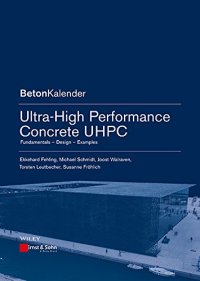
Ebook: Ultra-high performance concrete UHPC : fundamentals, design, examples
Author: edited by Ekkehard Fehling Michael Schmidt Joost Walraven Torsten Leutbecher Susanne Frohlich.
- Genre: Technique // Construction: Cement Industry
- Tags: Промышленное и гражданское строительство, Строительные конструкции, Железобетонные и каменные конструкции
- Series: Beton-Kalender series
- Year: 2014
- Publisher: Wiley-VCH
- City: Weinheim
- Language: English
- pdf
Selected chapters from the German concrete yearbook are now being published in the new English "Beton-Kalender Series" for the benefit of an international audience.
Since it was founded in 1906, the Ernst & Sohn "Beton-Kalender" has been supporting developments in reinforced and prestressed concrete. The aim was to publish a yearbook to reflect progress in "ferro-concrete" structures until - as the book's first editor, Fritz von Emperger (1862-1942), expressed it - the "tempestuous development" in this form of construction came to an end. However, the "Beton-Kalender" quickly became the chosen work of reference for civil and structural engineers, and apart from the years 1945-1950 has been published annually ever since.
Ultra high performance concrete (UHPC) is a milestone in concrete technology and application. It permits the construction of both more slender and more durable concrete structures with a prolonged service life and thus improved sustainability.
This book is a comprehensive overview of UHPC ? from the principles behind its production and its mechanical properties to design and detailing aspects. The focus is on the material behaviour of steel fibre-reinforced UHPC. Numerical modelling and detailing of the connections with reinforced concrete elements are featured as well. Numerous examples worldwide ? bridges, columns, fa?ades and roofs ? are the basis for additional explanations about the benefits of UHPC and how it helps to realise several architectural requirements.
The authors are extensively involved in the testing, design, construction and monitoring of UHPC structures. What they provide here is therefore a unique synopsis of the state of the art with a view to practical applications.
Since it was founded in 1906, the Ernst & Sohn "Beton-Kalender" has been supporting developments in reinforced and prestressed concrete. The aim was to publish a yearbook to reflect progress in "ferro-concrete" structures until - as the book's first editor, Fritz von Emperger (1862-1942), expressed it - the "tempestuous development" in this form of construction came to an end. However, the "Beton-Kalender" quickly became the chosen work of reference for civil and structural engineers, and apart from the years 1945-1950 has been published annually ever since.
Ultra high performance concrete (UHPC) is a milestone in concrete technology and application. It permits the construction of both more slender and more durable concrete structures with a prolonged service life and thus improved sustainability.
This book is a comprehensive overview of UHPC ? from the principles behind its production and its mechanical properties to design and detailing aspects. The focus is on the material behaviour of steel fibre-reinforced UHPC. Numerical modelling and detailing of the connections with reinforced concrete elements are featured as well. Numerous examples worldwide ? bridges, columns, fa?ades and roofs ? are the basis for additional explanations about the benefits of UHPC and how it helps to realise several architectural requirements.
The authors are extensively involved in the testing, design, construction and monitoring of UHPC structures. What they provide here is therefore a unique synopsis of the state of the art with a view to practical applications.
Download the book Ultra-high performance concrete UHPC : fundamentals, design, examples for free or read online
Continue reading on any device:

Last viewed books
Related books
{related-news}
Comments (0)